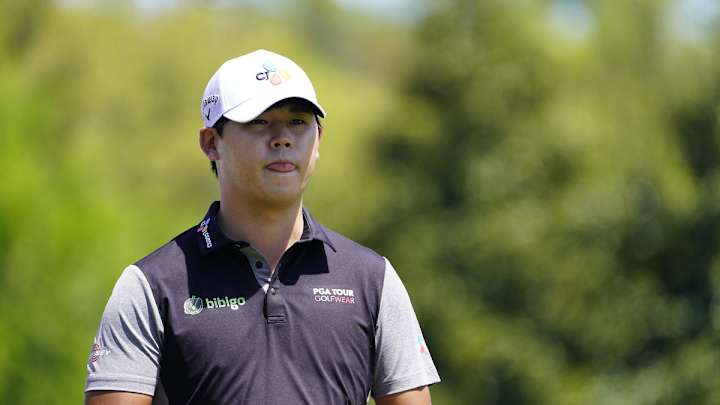On PGA Tour, only little guys get slapped for slow play

Out of nowhere, like a flash of summer lightning or an unexpected visit from a tiresome aunt, the PGA Tour dropped a bomb last week at Harbour Town. It penalized Si Woo Kim one stroke for violating Rule 13.3a, which allows a player “reasonable time” to approach the hole after a putt, then another 10 seconds of begging if his ball is teetering on the edge of the cup.
OK, so it wasn’t a bomb. More like a firecracker, loud enough to turn heads but not potent enough to cause serious injury. Kim did spend about a minute loitering at the scene of the crime after his superb birdie attempt from 15 feet off the second green during the third round stopped shamelessly on the lip. “It definitely exceeded time,” fellow competitor Matt Kuchar explained, “but as I go up there [to the hole], I go, ‘This ball is moving.’ You could tell it was moving. You can’t hit a moving ball, correct?”
Well, uh … Of course, Kim’s putt finally did tumble into the jar, opening a whole new can of worms. Kuchar’s performance as an amateur attorney fell on deaf ears; Kim’s marvelous birdie turned back into a par. Would a rules official have taken the same action if Tiger Woods had been the offender? Hmmm. You might remember a certain Nike hanging over the precipice of history on the 16th green in the final round of the 2005 Masters.
That was a very different situation from a legal standpoint. Woods’ ball fell in much quicker, nor could his journey to the flagstick be characterized as one of undue delay. As it just so happens, the very same tournament would produce backroom whispers that Woods intentionally slow-played the high-strung Chris DiMarco that afternoon in their duel for the ages.
By the way, how are we to quantify the term “reasonable time”? What exactly does that mean? One man’s prayer-filled pause is another man’s eternity. In a book full of micro-specifics, why is the Rules of Golf so vague on this matter? Thirty seconds in an elevator can feel like five minutes. God forbid if someone is about to hop onboard for the ride to the 27th floor.
There is a glaring inconsistency to the Kim penalty that warrants further review. Justin Thomas took more than three minutes to hit his tee shot at Sherwood Country Club’s par-3 15th at the Zozo Championship last fall. J.B. Holmes needs 90 seconds just to put on his glove. The big names and tour veterans get a free pass when it comes to pace of play. Kim takes a minute and change on a Saturday, gets the happy ending he was waiting for – and the Camp Ponte Vedra police decide to enforce an ambiguous rule because a ball is declared to be “at rest” when it obviously wasn’t?
It’s enough to leave you thinking a pro golfer has been made into an example. Kim is from South Korea, who at age 21 in 2017 was the youngest man ever to win the Players Championship, although he recently acquired a huge new batch of fame for busting his putter earlier this month at the Masters. He is not a star, at least in this country, and when you process the fact that Tour referees have called a grand total of two actual slow-play penalties since 1995, the sudden call to action during the third round at Harbour Town smells a lot like a dumpster in Jersey City.
This brand of justice is in dire need of an explanation. Perhaps you recall the two-stroke fine that Masters officials levied on 14-year-old Tianlang Guan in 2013, another of those rotten-fish episodes that didn’t prevent the Chinese kid from becoming the youngest player to make the cut at a major championship. Frenchman Gregory Bourdy was docked a couple of shots at the 2010 PGA. Argentina’s Miguel Angel Carballo and obscure American Brian Campbell, playing as a team four years ago in New Orleans, were the last guys to get hit with sanctions by the Tour for taking too long.
Not for nothing, J.B. Holmes is still working on that glove.
No sports organization turns a deaf eye with more dexterity than the game’s mightiest competitive empire. The Tour obviously believes that image means everything when it comes to peddling its product to the masses, and it’s hard to argue with that notion. It’s also difficult to claim that pro golf doesn’t have a slow-play problem without breaking out in laughter. You could flag 10 tortoises per round without breaking a sweat, but that wouldn’t be good for business.
At the end of the day, whether the entire field finishes or not, that’s what this is all about. Business comes first, and few are more successful (or self-sustainable) than the operation run by the suits in northeast Florida. You don’t blow up the bridge because there are a couple of potholes. The model works nicely, at least until random and extremely rare acts of enforcement result in judgments such as the one imposed on Kim.
Yes, it was just one stroke. He still finished T-33, still made $37,866, but that doesn’t make it right. Right, J.B.?
Sign up to receive the Morning Read newsletter, along with Where To Golf Next and The Equipment Insider.
